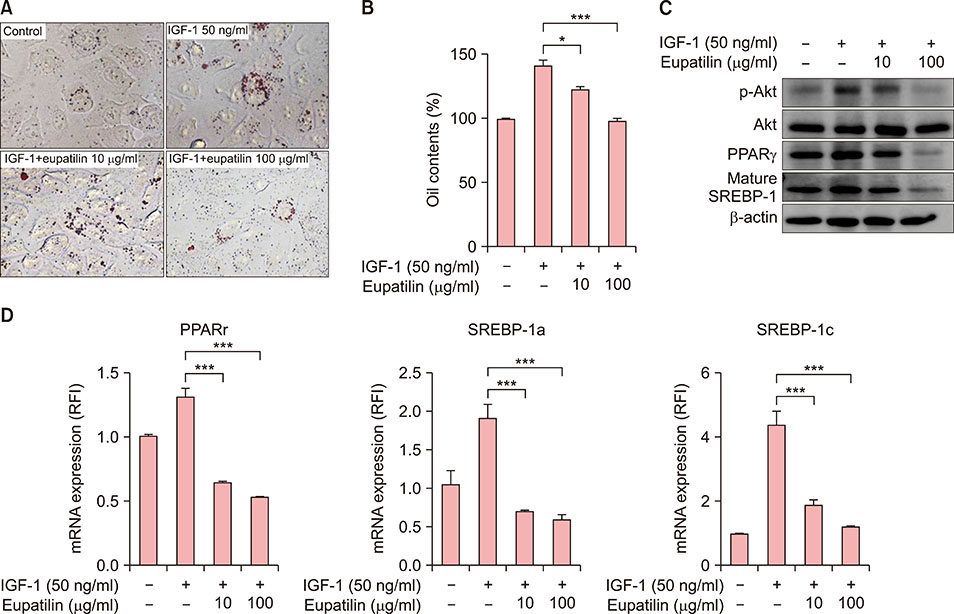Ann Dermatol.
2019 Aug;31(4):479-482. 10.5021/ad.2019.31.4.479.
Effects of Eupatilin on Insulin-Like Growth Factor 1-Induced Lipogenesis and Inflammation of SZ95 Sebocytes
- Affiliations
-
- 1Department of Dermatology, Seoul St. Mary's Hospital, College of Medicine, The Catholic University of Korea, Seoul, Korea. yymmpark6301@hotmail.com
- 2Department of Biomedicine & Health Sciences, College of Medicine, The Catholic University of Korea, Seoul, Korea.
- 3Department of Dermatology, Venereology, Allergology and Immunology, Dessau Medical Center, Dessau, Germany.
- KMID: 2451494
- DOI: http://doi.org/10.5021/ad.2019.31.4.479
Abstract
- No abstract available.
MeSH Terms
Figure
Reference
-
1. Zouboulis CC. Acne and sebaceous gland function. Clin Dermatol. 2004; 22:360–366.
Article2. Melnik BC, Schmitz G. Role of insulin, insulin-like growth factor-1, hyperglycaemic food and milk consumption in the pathogenesis of acne vulgaris. Exp Dermatol. 2009; 18:833–841.
Article3. Lee JH, Lee YJ, Lee JY, Park YM. Topical application of Eupatilin ameliorates atopic dermatitis-like skin lesions in NC/Nga mice. Ann Dermatol. 2017; 29:61–68.
Article4. Choi EJ, Oh HM, Na BR, Ramesh TP, Lee HJ, Choi CS, et al. Eupatilin protects gastric epithelial cells from oxidative damage and down-regulates genes responsible for the cellular oxidative stress. Pharm Res. 2008; 25:1355–1364.
Article5. Lee SH, Bae EA, Park EK, Shin YW, Baek NI, Han EJ, et al. Inhibitory effect of Eupatilin and jaceosidin isolated from Artemisia princeps in IgE-induced hypersensitivity. Int Immunopharmacol. 2007; 7:1678–1684.
Article6. Engelking LJ, Kuriyama H, Hammer RE, Horton JD, Brown MS, Goldstein JL, et al. Overexpression of Insig-1 in the livers of transgenic mice inhibits SREBP processing and reduces insulin-stimulated lipogenesis. J Clin Invest. 2004; 113:1168–1175.
Article7. Smith TM, Gilliland K, Clawson GA, Thiboutot D. IGF-1 induces SREBP-1 expression and lipogenesis in SEB-1 sebocytes via activation of the phosphoinositide 3-kinase/Akt pathway. J Invest Dermatol. 2008; 128:1286–1293.
Article8. Trivedi NR, Cong Z, Nelson AM, Albert AJ, Rosamilia LL, Sivarajah S, et al. Peroxisome proliferator-activated receptors increase human sebum production. J Invest Dermatol. 2006; 126:2002–2009.
Article9. Ferré P. The biology of peroxisome proliferator-activated receptors: relationship with lipid metabolism and insulin sensitivity. Diabetes. 2004; 53:Suppl 1. S43–S50.
Article10. Choi Y, Jung Y, Kim SN. Identification of Eupatilin from Artemisia argyi as a selective PPARα agonist using affinity selection ultrafiltration LC-MS. Molecules. 2015; 20:13753–13763.
Article
- Full Text Links
- Actions
-
Cited
- CITED
-
- Close
- Share
- Similar articles
-
- Azidothymidine Downregulates Insulin-Like Growth Factor-1 Induced Lipogenesis by Suppressing Mitochondrial Biogenesis and Mitophagy in Immortalized Human Sebocytes
- Inhibition of Insulin-Like Growth Factor-1–Induced Sebum Production by Bilobetin in Cultured Human Sebocytes
- Platycodin D May Improve Acne and Prevent Scarring by Downregulating SREBP-1 Expression Via Inhibition of IGF-1R/PI3K/Akt Pathway and Modulating Inflammation with an Increase in Collagen
- Effects of Eupatilin on the Release of Leukotriene B4 , by Helicobacter pylori - stimulated Neutrophils and Gastric Mucosal Cells
- The SCAP/SREBP Pathway: A Mediator of Hepatic Steatosis



